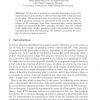Free Online Productivity Tools
i2Speak
i2Symbol
i2OCR
iTex2Img
iWeb2Print
iWeb2Shot
i2Type
iPdf2Split
iPdf2Merge
i2Bopomofo
i2Arabic
i2Style
i2Image
i2PDF
iLatex2Rtf
Sci2ools
73
Voted
KI
2008
Springer
2008
Springer
Fusing DL Reasoning with HTN Planning
We describe a method for cascading Description Logic (DL) representation and reasoning on the one hand, and HTN action planning on the other. The planning domain description as well as the fundamental HTN planning concepts are represented in DL and can therefore be subject to DL reasoning; from these representations, concise planning problems are generated for HTN planning. We show that this method yields significantly smaller planning problem descriptions than regular representations do in HTN planning. The method is presented by example of a robot navigation domain.
| Added | 13 Dec 2010 |
| Updated | 13 Dec 2010 |
| Type | Journal |
| Year | 2008 |
| Where | KI |
| Authors | Ronny Hartanto, Joachim Hertzberg |
Comments (0)

